- November 24, 2024
-
-
Loading

Loading

Executive: Christopher Pacitto, president and owner, Velocity Engineering, Fort Myers
Diversion: Cave diving
How he got started: “I've always loved the water,” says Pacitto. “I grew up swimming and boating.” A friend in college introduced him to scuba diving and he became certified in 2002 with his wife, Michelle.
Reefs and wrecks: Initially, Pacitto enjoyed diving reefs and shipwrecks in the Florida Keys, the Caribbean, Mexico and Hawaii. He became an advanced open-water diver and learned to use Nitrox, a form of enriched-oxygen air that allows divers to stay underwater longer than with normal compressed air.
Photography: Pacitto became skilled at underwater photography, diving two to three weekends a month before his daughter was born in 2007. He had some photos published in Sport Diver magazine, for which he got paid. “It was never for the business side of it,” he says.
Deeper dive: In his quest to reach deeper inside shipwrecks for photography, Pacitto took an advanced course on decompression procedures and advanced use of Nitrox to manage dives of 150 feet. But his instructor told him a cave diving certification would provide even better training. His first cavern dive was in Ginnie Springs in North Florida. “I absolutely loved it,” he says.
Full cave: Pacitto earned the most advanced level of cave diving from the National Speleological Society Cave Diving Section. In all, it consists of four three-day courses to achieve full certification for cave diving, including drills such as getting out of a cave in total darkness.
Pacitto loved the thrill of reaching places few people have gone. He's dived as deep as 200 feet and the furthest he's gone into a cave system is 2,400 feet. “There's very little life down there,” he says.
Plus, as a geotechnical engineer, Pacitto is fascinated by what he sees underground. “Going inside the earth and seeing what's happening from the inside has given me a lot better understanding,” he says.
Cave central: “North Florida is the cave-diving Mecca of the world,” says Pacitto. The network of spring-fed caves extends from north of Tampa to the Tallahassee area. “It's like Disneyland for cave divers,” he says. Pacitto says he also likes cave diving in Mexico. For example, caves in Mexico have stalactites and stalagmites, which don't occur in Florida caves.
Safety first: Cave diving requires more precaution than open-water diving for obvious reasons. Redundancy is key if a piece of equipment fails. Pacitto dives with at least two main air tanks, another two stage tanks for the return home, two breathing regulators and two lights. Because the water is a constant 72 degrees, Pacitto wears a dry suit that keeps him warm when he's diving for one to two hours at a time. All this equipment isn't cheap. For example, a good light costs $2,500 and a decent backup light costs about $800, but it's critical for safety.
Less dangerous than I-75: Pacitto puts the danger of cave diving in perspective. “I see more dead bodies on the side of I-75 than cave diving,” he says. Still, Pacitto says he remains focused on safety. “I try to stay within my limits and comfort level,” he says. Sometimes, Pacitto says it's better to go alone than with a dive buddy. “The most dangerous thing underwater is other people,” he says. “Some of the smaller passages a buddy can't be much help anyway. Nobody can help you out.”
Pacitto says he's never been in any real danger, though he's had some lights break and one of his buddy's inflator valves on a buoyancy vest broke. “His problem is my problem,” Pacitto says. “Sometimes I feel better doing it by myself.”
Pacitto's wife approves of his activity even though they have an 8-year-old daughter. “She's OK with it,” he says. “I generally know what I'm doing and I don't take too many risks,” he says.
- Jean Gruss, Editor/Lee-Collier